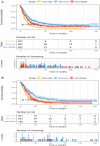Development and validation of a nomogram to predict cancer-specific survival of elderly patients with unresected gastric cancer who received chemotherapy
- PMID: 38637579
- PMCID: PMC11026516
- DOI: 10.1038/s41598-024-59516-3
Development and validation of a nomogram to predict cancer-specific survival of elderly patients with unresected gastric cancer who received chemotherapy
Abstract
This investigation aimed to explore the prognostic factors in elderly patients with unresected gastric cancer (GC) who have received chemotherapy and to develop a nomogram for predicting their cancer-specific survival (CSS). Elderly gastric cancer patients who have received chemotherapy but no surgery in the Surveillance, Epidemiology, and End Results Database between 2004 and 2015 were included in this study. Cox analyses were conducted to identify prognostic factors, leading to the formulation of a nomogram. The nomogram was validated using receiver operating characteristic (ROC) and calibration curves. The findings elucidated six prognostic factors encompassing grade, histology, M stage, radiotherapy, tumor size, and T stage, culminating in the development of a nomogram. The ROC curve indicated that the area under curve of the nomogram used to predict CSS for 3, 4, and 5 years in the training queue as 0.689, 0.708, and 0.731, and in the validation queue, as 0.666, 0.693, and 0.708. The calibration curve indicated a high degree of consistency between actual and predicted CSS for 3, 4, and 5 years. This nomogram created to predict the CSS of elderly patients with unresected GC who have received chemotherapy could significantly enhance treatment accuracy.
Keywords: Chemotherapy; Elderly patients; Gastric cancer; Nomogram; SEER database.
© 2024. The Author(s).
Conflict of interest statement
The authors declare no competing interests.
Figures





Similar articles
-
The nomograms for predicting overall and cancer-specific survival in elderly patients with early-stage lung cancer: A population-based study using SEER database.Front Public Health. 2022 Sep 8;10:946299. doi: 10.3389/fpubh.2022.946299. eCollection 2022. Front Public Health. 2022. PMID: 36159305 Free PMC article. Clinical Trial.
-
Development and validation of a nomogram to predict the prognosis of patients with gastric cardia cancer.Sci Rep. 2020 Aug 24;10(1):14143. doi: 10.1038/s41598-020-71146-z. Sci Rep. 2020. PMID: 32839498 Free PMC article.
-
Nomograms for predicting overall survival and cancer-specific survival in elderly patients with epithelial ovarian cancer.J Ovarian Res. 2023 Apr 14;16(1):75. doi: 10.1186/s13048-023-01144-y. J Ovarian Res. 2023. PMID: 37059991 Free PMC article. Clinical Trial.
-
Development and validation of nomograms for predicting survival of elderly patients with stage I small-cell lung cancer.Bosn J Basic Med Sci. 2021 Oct 1;21(5):632-641. doi: 10.17305/bjbms.2020.5420. Bosn J Basic Med Sci. 2021. PMID: 33577444 Free PMC article.
-
Development and validation of nomograms for predicting overall survival and cancer-specific survival in elderly patients with locally advanced gastric cancer: a population-based study.BMC Gastroenterol. 2023 Apr 11;23(1):117. doi: 10.1186/s12876-023-02749-9. BMC Gastroenterol. 2023. PMID: 37041468 Free PMC article. Clinical Trial.
Cited by
-
Gastric Carcinoma Patients with Advanced Pathological Lymph Node Stage Benefit from Postoperative Radiotherapy: A Retrospective Analysis.J Gastrointest Cancer. 2025 May 22;56(1):122. doi: 10.1007/s12029-025-01219-7. J Gastrointest Cancer. 2025. PMID: 40402361
-
Application and progress of nomograms in gastric cancer.Front Med (Lausanne). 2025 Jan 29;12:1510742. doi: 10.3389/fmed.2025.1510742. eCollection 2025. Front Med (Lausanne). 2025. PMID: 39944483 Free PMC article. Review.
-
Development and validation of nomograms for predicting overall survival and cancer-specific survival in unresected colorectal cancer patients undergoing chemotherapy.Sci Rep. 2025 Apr 11;15(1):12477. doi: 10.1038/s41598-025-96526-1. Sci Rep. 2025. PMID: 40216848 Free PMC article.
References
MeSH terms
LinkOut - more resources
Full Text Sources
Medical
Miscellaneous

